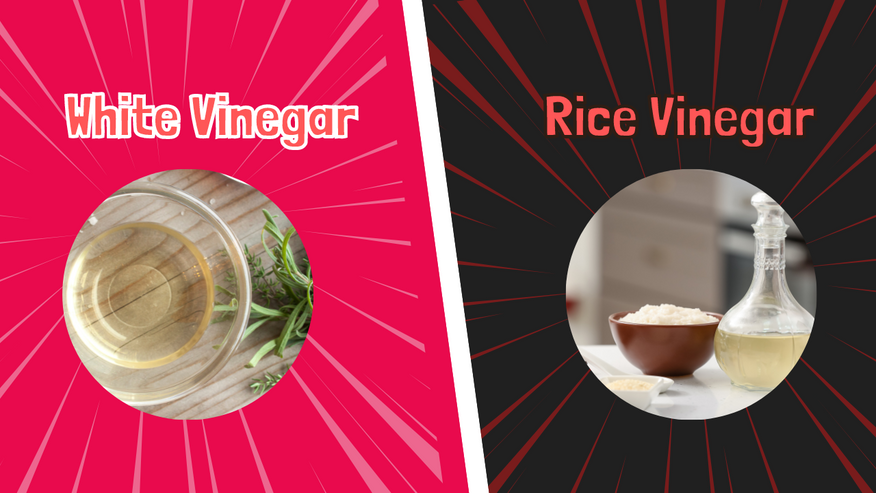Mar 17th 2023 - Team
Rice Vinegar Vs. White Vinegar: The Differences
This article explores different types of vinegar that can substitute for rice vinegar, their culinary applications, and the health benefits associated with them.
Rice Vinegar Vs. White Vinegar
Vinegar is well-known for its distinctive sour flavor. Even though there are a lot of different kinds of vinegar on the market, they all serve the same function in the kitchen. Vinegar improves the flavor of a meal by adding acidity or tartness.
The acidity of both rice vinegar and white vinegar is the same. Their odor and distinct flavor are also reminiscent of vinegar. Nonetheless, they differ significantly from one another in two important ways.
Fermented grain alcohol is used to create white vinegar, whereas fermented rice produces rice vinegar.

Rice vinegar has a tart and sweet taste but is less acidic than regular white vinegar.
White vinegar is more acidic and sour than its red counterpart
White vinegar and rice are both sour, but rice also has a sweet taste to it. Choose white wine if you prefer a stronger sour flavor. But if you'd like something with a bit less sourness and more sweetness, try some rice.
Color
White vinegar and rice wine vinegar have slightly different hues. Both sorts are transparent. However, normal white vinegar has a whitish tint to it, while distilled white vinegar is absolutely clear. Most rice vinegar has a very light yellow hue.
Origin
Rice vinegar was invented in Asia and is considered a staple in Asian cuisine. Although rice vinegar is used all over the world, it is most popular in Vietnamese, Chinese, Korean, Vietnamese, and Japanese dishes.
White vinegar is a more common vinegar in Western cooking.
What Is Rice Vinegar?
The use of rice vinegar in Asian dishes is as ancient as the continent itself. It is most commonly seen in Chinese, Korean, Japanese, and Vietnamese cooking. Yet, you can find rice vinegar in any corner of the globe.
In Western cuisines, white vinegar predominates.
Other Uses

Vinegar made from rice is a key ingredient in many Asian recipes.
These are a few excellent applications of rice vinegar:
The use of rice vinegar in marinades and dipping sauces is highly recommended. If you want a dipping sauce that goes well with Chinese and Japanese food, try combining soy sauce and rice vinegar. Occasionally, I'll also add some minced garlic and ginger.
To add a tangy and slightly sweet flavor to your stir-fry, try using rice vinegar.
Rice vinegar can be used to make a sour and sweet vinaigrette or salad dressing with an Asian twist.
To make sushi rice, rice vinegar is a crucial component.
What Is White Vinegar?
In order to produce white vinegar, acetic acid is first produced by the fermentation of grain alcohol (ethanol). When the vinegar is fermented, water is added, reducing the concentration of the acetic acid to between 5% and 10% and increasing the water content to between 90% and 95%. The resulting vinegar is transparent and sharp, with a rather neutral taste. Every grocery shop should stock white vinegar because it is the most prevalent type of vinegar.
Uses for White Vinegar

White vinegar has several uses, including those in the kitchen and around the house.
Use white vinegar as a pickling agent for vegetables and fruits or in a vinaigrette, salad dressing, marinade, or sauce.
White vinegar can be used as a household cleaner, and there are varieties of vinegar designed specifically for this purpose. The normal alcohol content is 20%, making them unsafe for human ingestion. Vinegar, with antibacterial properties, is useful for cleaning dishes, counters, and clothes.
Can You Substitute White Vinegar For Rice Vinegar?
Although white vinegar and rice vinegar look similar, their flavor profiles couldn't be more different. Compared to white vinegar, which is acidic and harsh, rice vinegar is mellow and pleasant. But if you do it right, white vinegar can stand in for rice vinegar.
Any recipe calling for rice vinegar can easily be adapted to use white vinegar instead. It will have a more acidic and sour taste, but this can easily be remedied by adding sugar. Sugar neutralizes acidity and sour flavor.
White vinegar can be replaced with rice vinegar at a 1:1 ratio. Then, gradually add a pinch of sugar to taste.
It's important to remember that any time sugar is added to a recipe, calories are also increased.
Best Substitutes for Rice Vinegar

White vinegar can be used instead of rice vinegar in most recipes, although it's not as good of a substitute as rice vinegar.
Apple cider vinegar is a great alternative to rice vinegar. It has a mellow, delicate flavor that won't steal the show from other ingredients.
When you need a replacement for another type of vinegar, apple cider vinegar is an excellent option.
Using apple cider in place of rice vinegar is a one-to-one swap.
Besides being versatile vinegar for use in the kitchen, apple cider is also said to have positive effects on one's health. These benefits extend to reducing body fat, blood pressure, the frequency of headaches and migraines, and sugar levels. Consider sprinkling a capful into your food rather than gulping it down daily.
The apple, fruity flavor of apple cider vinegar is greatly diminished when it is used in cooking. But the hint of apple flavor really shines through when the fruit is pickled.
Other Rice vinegar substitutes
People can use other vinegar in place of rice vinegar, and there are many options that they may already have at home or can easily find at a grocery shop or health food store.
- Among these are:
- Champagne vinegar
- White wine vinegar
- Lemon juice
- Lime juice
- Distilled white vinegar
- White balsamic vinegar

